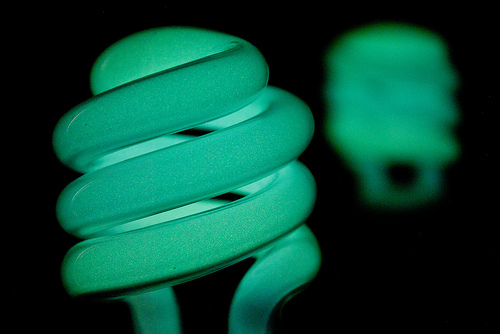Send your question to Umbra!
Q. Dear Umbra,
My sister recently posted a story about CFLs causing cancer to her Facebook feed. Is there anything to this latest attempt to vilify the little lamps?
Brian
Spokane, Wash.
 Are these maybe not such a bright idea? More research is needed.Photo: Derek GaveyA. Dearest Brian,
Are these maybe not such a bright idea? More research is needed.Photo: Derek GaveyA. Dearest Brian,
Those little lamps. They need defending again. I don’t know what it is about compact fluorescent bulbs. The odd, gentle curve of the bulb? The way they, oh, save people energy and money? How they reduce pollution? Something about them brings out the haters.
No haterade for us, Brian. We will be swilling the sweet lemonade of reduced energy use.
I took a look at the piece in The Telegraph that your sister posted, and I admit that I got a bit excited. Nothing gives me a thrill like putting on the ol’ Debunking Hat and investigating some spurious journalism. Essentially, some scientists in Germany said CFLs release cancer-causing chemicals while turned on (and that you should not use them close to your head or in an unventilated area). I’ve written before on the minuscule amount of mercury CFLs contain, and how they keep up to 10 times as much mercury as they contain out of the environment, but this is a new one.
Let’s start with the headline: “Energy-saving light bulbs ‘contain cancer-causing chemicals.'” Hmm. What else contains cancer-causing chemicals? How about certain kinds of makeup, canned-food linings, perfume, plastic bottles, lube, conventional candles, and sunscreen — and we rub some of those all over ourselves. As far as I know, nobody is rolling around in CFLs (and I am not suggesting we start). We encounter myriad other health risks in our environment every day (car exhaust! VOC paint! heavy metals in our electronics!) but those have deep-pocketed industries behind them to sell us on the sexiness and necessity of things that are harmful to our health and the environment in their production and disposal.
But let’s zoom in for a closer look. The chemicals in question are phenol, naphthalene, and styrene — and they’re hardly only found in CFLs. Phenol is used in making our nemesis bisphenol A, and can be found, among other places, in mouthwash and cough drops. Naphthalene is involved in making PVC plastics, mothballs, and diaper-pail deodorizers. Styrene (not to be confused with Poly Styrene, RIP) offgasses from building materials, cigarette smoke, and copy machines. It’s also found in shoes. (Shoes! I would love to see a piece in The Telegraph about how we should stop wearing shoes because scientists discovered they contained a carcinogenic ingredient.)
Next, buried below the fold — unseen by skimming web-surfers who have already forwarded the link, I’m afraid — one finds this:
British experts insisted that more research was needed and urged consumers not to panic.
Dr. Michelle Bloor, senior lecturer in Environmental Science at Portsmouth University, told the Daily Express: “Further independent studies would need to be undertaken to back up the presented German research.”
An important sentence one fears many readers will gloss over. I hope further research is done — we can be alarmed later if numerous, reputable studies support these German researchers. Until then, we should all focus our energies on worrying about more important things. Like making our cities more livable. Improving public transportation. Holding politicians accountable for their Earth-destroying tendencies. Pressuring companies to create less waste and use less-toxic ingredients. Eating food that’s grown closer to us and with fewer pesticides. Spending more time with the people we love instead of being enslaved to our possessions. (Fill in the blank.)
If CFLs are still worrisome to your sister, Brian, you can always remind her to use them in a well-ventilated room (a precaution she should also take with things like paraffin candles and toxic paint, which interestingly enough have not warranted Telegraph articles) or point her to LEDs.
Finally, I’m not a regular reader of The Telegraph, so I can’t speak as to its reputableness, but it’s a historically conservative paper that’s also currently running stories on how Viagra “could” make you deaf and about a man who says he had sex with a thousand cars. Food for thought.
Skeptically,
Umbra


